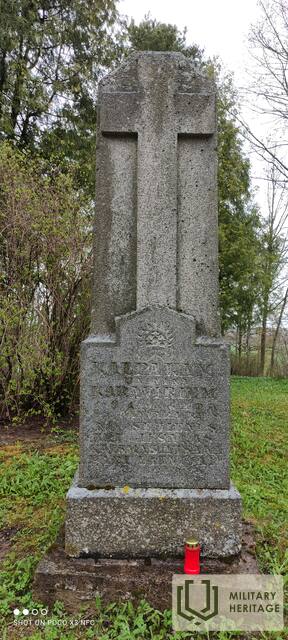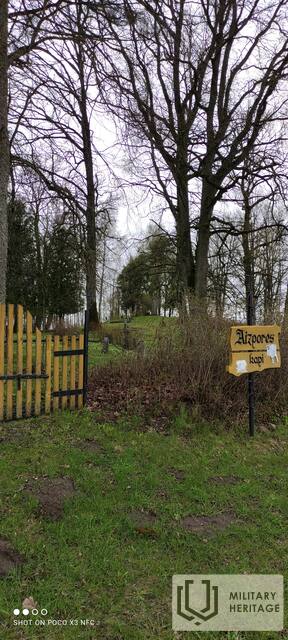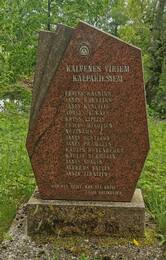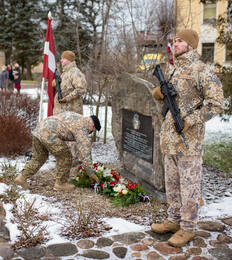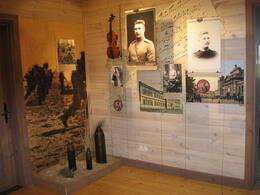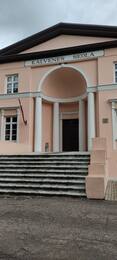Aizporu half manor in the War of Independence
Das Halbgut Aizporu, Kreis Aizpute, Gemeinde Kalvene, ist der westlichste Ort in Lettland, in den sich das Separatistenbataillon von Oberst Oskars Kalpaks zurückzog.
Auf halbem Weg zwischen Rudbārži und Kalvenė liegt am Straßenrand der Friedhof von Aizpore. Dort befinden sich ein Denkmal und 12 Gedenkstätten für die freiwilligen Soldaten des Bataillons von Oskars Kalpaka.
Im Januar 1919, nachdem es Jelgava über Lielauce verlassen hatte, wo die erste Schlacht im Unabhängigkeitskrieg ausgetragen wurde, erreichte das Bataillon des Obersten Oskars Kalpaks, nachdem es Venta gezwungen hatte, die Herrenhäuser Lēne und Rudbārži. Am frühen Morgen des 22. Januar nahm das Bataillon von Oberst O. Kalpaks Verteidigungsstellungen an der Kreuzung der Autobahn Liepāja - Jelgava und der Straße Embūte - Valtaiķi im Gebiet des Halbguts AIZPORU ein. Links die Baltische Landeswehr, rechts die Deutsche Eisen-Division. Da der weitere Angriff der sowjetischen lettischen Truppen von Skrunda aus nicht folgte, kehrte das Bataillon O. Kalpaks auf seine früheren Positionen im Herrenhaus RUDBĀRŽI zurück.
Im Jahr 1922 errichteten die ehemaligen Männer des Kalpaka-Bataillons ein temporäres Gedenkzeichen - einen Eichenblock mit einer Kupferplatte.
In den 1930er Jahren hat die O. Kalpaks-Gesellschaft ein Denkmal für den Bildhauer Jānis BRIEDIS "Anfang" in Auftrag gegeben, sowie die Idee einer großen Gedenkstätte mit einer Eiche - Varoņi Allee bis Rudbārži Gutshof - wird gefördert und akzeptiert von der Präsident von Lettland. Der Bildhauer Kārlis JANSONS erwirbt das Recht, die Gedenkstätte zu verkaufen.
Aufgrund der Tatsache, dass die Hauptfinanziers der Herstellung des Denkmals Studentenwerke sind, wird in Pinki das Denkmal für J. Briežs errichtet, das am 15. Mai 1939 errichtet wurde (das restaurierte Denkmal befindet sich in Pinki) zu Ehren der zugehörigen Studentengesellschaft zum O. Kalpaks-Bataillon.
1940, mit der Besetzung Lettlands, kamen die Pläne zum Verkauf der Gedenkstätte zum Erliegen. Nach inoffiziellen Angaben wurde die geplante Heldenallee teilweise durch das Anpflanzen von Eichen aus dem Gut Rudbārži in Richtung Aizporai realisiert und ist heute in der Nähe der Autobahn Liepāja sichtbar.
Ein moderner Gedenkort
Nach der Wiederherstellung der Unabhängigkeit der Republik Lettland am 15. Mai 1993 wurde ein Gedenkzeichen - der Lichtstrahl - enthüllt. Das 2,3 m hohe Gedenkzeichen aus grauem Granit wurde von den Bildhauern Harijs SPRINCIS und Imants LUKAŽIS (1930 - 2007, begraben auf dem Friedhof von Aizporu) geschaffen, deren Vater auch Soldat des Bataillons O. Kalpaks ist. Auf dem Gedenkschild sind die Worte des Dichters Ed.VIRZAS eingraviert:
KALPAKAM
UND SEIN
FÜR SOLDATEN
1919. JAHR
MORGEN, 25. JANUAR
VON HIER
AUCH STARTEN
WEAVING GEWICHT
ÜBER LETTLAND
Quelle: Lismanis, J. 1915-1920. In Erinnerung an Schlachten und gefallene Soldaten: Gedenkstätten des Ersten Weltkriegs und des lettischen Befreiungskampfes. Riga: NIMS, 1999. p.
Zugehörige Zeitleiste
Related topics
Related objects
Monument and memorial markers to the soldiers of O. Kalpaka Battalion at Aizpore Cemetery
About halfway between Rudbārži and Kalvė, on the side of an old road parallel to the A9 highway, is the Aizpore Cemetery.
There is a monument and 12 memorials to the volunteer soldiers of Oskars Kalpaka's battalion, who lived in the surrounding houses.
The Aizpore half-manor of the Kalvene municipality was the farthest place to which the Latvian Separate (Kalpaka) Battalion retreated on 22 January 1919. Here the battalion received its first reinforcements from Liepāja - 35 men and launched a counter-attack, reaching Rudbārži on 24 January.
The idea of erecting a monument was conceived in the 1920s, when former soldiers of the 1st Latvian Separate Battalion, or Kalpaka Battalion, erected a temporary memorial sign - a block of oak with a plaque. At that time, the idea of creating a larger memorial ensemble was born, but it was only realised on 15 May 1993, when the memorial sign - the Ray of Light - was unveiled - an obelisk made of grey granite.
The 2.3 m high memorial sign is made by sculptors Harijs SPRINCIS and Imants LUKAŽIS (1930 - 2007, buried in Aizpuri Cemetery), whose father was also a soldier of O. Kalpaka's battalion. The names of the poet E.VIRZA are engraved on the memorial sign:
KALPAKAM
AND HIS
TO THE SOLDIERS
1919
MORNING OF 25 JANUARY
FROM THIS DAY
ALSO FROM
FIRE
OVER LATVIA
At the same time, the graves of the 12 Kalpaks buried in the cemetery were marked with oak memorial plaques, which were replaced by granite markers in 2019.
In the early 1990s, a two-metre-high monument was erected in the cemetery, next to which grows an oak tree planted in the mid-1990s by the legendary actor Ēvalds Valters.
Battle of Skrunda Memorial and Flag Day
The Skrunda Battle Memorial is located in the centre of Skrunda, in Oskaras Kalpaka Park near the Skrunda Culture House, at the intersection of Kuldīgas and Liepājas Streets. In 2005, a stone was erected at the memorial commemorating the battle of 29 January 1919, when the battalion commanded by Oskars Kalpaks, together with the German and Russian units of the Landeswehr, liberated Skrunda from the Bolsheviks. The tradition of Flag Day has been maintained since 2004, commemorating the first town liberated from the Bolsheviks and its liberators, who raised the Latvian flag at the Skrunda church on 29 January 1919.
During the first months of the War of Independence, the Latvian Provisional Government, under pressure from the Bolsheviks, was rapidly losing territory. On 22 January 1919, the Bolsheviks captured Skrunda. A week later, in the early hours of 29 January, the offensive to recapture Skrunda began. The Latvian Separate Battalion under Lieutenant Colonel Oskars Kalpaks was to attack along the Rudbāržu-Skrunda highway and drive the Bolsheviks out of Skrunda. This would be followed by a flank attack by German units with the task of destroying the advancing enemy, while the Russian company would attack between the Latvian and German units, using the Skrunda church as a landmark. The attack was also supported by a German artillery battery. On the day of the attack, the frost was 15 degrees, the sun shone brightly, the Kalpaks had to cross a clear field, and the Bolsheviks were sheltering in the stone buildings of the manor. The Bolsheviks opened fire when the chain of attackers was about 300 metres away, a two-way firefight broke out, and the soldiers under Oskars Kalpaks' command advanced in a rapid advance, forcing the enemy to cease fire and retreat across the Venta. After about 3 hours of fighting, Skrunda was captured at about 9am, with the Latvian Separate Battalion having only 2 wounded.
The Battle of Skrunda was of great importance for the morale of the Latvian Provisional Government's armed Spek soldiers, as it was in fact the first significant victory in the battles against the Bolsheviks. Moreover, the commander himself, Oskars Kalpaks, showed particular courage in the battle, encouraging the soldiers by his example not to be afraid.
Oskars Kalpaks Museum and Memorial Site “Airītes”
The Oskars Kalpaks Museum and Memorial Site Airītes is located between Saldus and Skrunda near the A9 highway. The exhibit has extensive information about Colonel Oskars Kalpaks and his battalion, and shows the history of the Latvian National Army and the memorial site Airītes. The exhibit reveals Colonel Oskars Kalpaks as a personality, as a soldier and as a fighter for Latvia's independence. Audio logs in Latvian, English and German are also available as part of the exhibit. They emphasize the importance of the historic events of 1918/1919 in the protecting the statehood of Latvia. The museum building has been restored.
Entry is free; guided tour – for a fee. The complex has a recreation area, a park, an obstacle course, it is possible to take various classes, and there is a seminar hall for up to 30 people.
Tāšu - Padure Manor
The Tasi - Padure Manor Castle is now known as Kalvene Primary School, founded in 1922. The school building was built in the 19th century in the late classical style as a hunting lodge for Count Keizerling.
At the beginning of 1919, the first mobilised men who answered the call for mobilisation gathered here and came to the manor. On 22 January 1919, the Latvian Separate Cavalry Unit was established here, one of whose leaders went to the 1st Latvian Separate Battalion commanded by O.Kalpaks on 24 January. The whole unit (about 80 soldiers in total) under the command of commander Arnolds Artum-Hartmanis arrived in Rudbārži on 1 March.
Kalvene Primary School is a national cultural monument. In the 1960s, the castle was renovated and adapted to the needs of the school.
Steles in memory of the knights of the War Orders of Lāčplēš
Twenty-seven knights of the Lāčplēš Military Order are associated with the Aizpute region.
Commemorative stelae of a uniform pattern were erected throughout Latvia in honor of the soldiers who fell in the Latvian Freedom Struggle, in which the text engraving font corresponds to the standard of the heroes' memorial plaques, which is analogous to the engraving of the sandstone memorials of the Riga Brothers' Grave and Central Graveyard.
The granite stelae were created as part of the "Remember Lāčplēšus" project of the Young Guard and Information Center dedicated to the centenary of the Latvian state.




